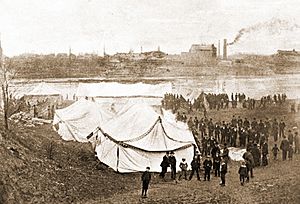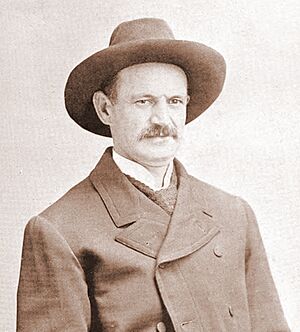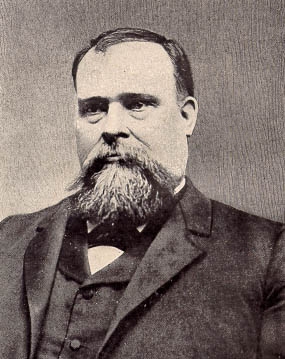Fry's Army facts for kids
Fry's Army was the name given to a protest group in 1894. It was started in Los Angeles, California, by a trade union leader and socialist named Lewis C. Fry. This "army" was one of about 40 similar groups formed in 1894. Their goal was to gather unemployed workers and march to Washington, D.C.. They wanted to ask the government for help during a tough economic time. The most famous of these groups was Coxey's Army, which started in Ohio.
Fry's Army began with 850 people. They had a very hard journey across the country, mostly on foot. This was because train companies refused to give them free rides. During their march, they took control of two trains, which led to problems with the police. However, the Governor of Texas helped them, preventing many arrests. But their train journey ended in St. Louis. The remaining members had to walk the rest of the way. Because of these tough conditions, the group slowly broke apart. It even split into two smaller groups in Indiana. Only a few protestors finally reached Washington, D.C., with Fry. Their efforts there did not achieve much.
Contents
History of Fry's Army
Why Fry's Army Formed
The American economy faced a very difficult time in the 1890s. This period is known as the Panic of 1893. It began in May 1893 with a big drop in the stock market. By the end of 1893, more than 16,000 businesses and 500 banks had closed. This left about 2 million people without jobs. By 1894, nearly 20% of workers who were not farmers had lost their jobs.
Lewis C. Fry was a former soldier and a leader in the American Federation of Labor. He was also a member of the Socialist Labor Party of America. Fry was very interested in the idea of "Industrial Armies." These groups wanted to gather unemployed workers. They would then march to the U.S. Congress in Washington, D.C. Their goal was to demand changes to end the economic crisis.
In February 1894, a short-term program to help unemployed people in Los Angeles was ending. That's when "General" Fry started to organize his "Industrial Army." Fry was good at public speaking and used to political action. He carefully checked everyone who wanted to join his group.
On March 5, Fry's new "army" agreed on three main goals. They wanted the government to create jobs for the unemployed. They also wanted to stop immigration to the United States for ten years. Finally, they wanted to prevent people who were not citizens from owning land. By mid-March, over 800 people had joined. They began to prepare for the journey east. Fry asked supporters to donate food and blankets for the marchers.
The Journey Begins
Fry first tried to get the Southern Pacific Railroad to give his group free train rides. The railroad said no to this request. So, on March 16, 1894, Fry and about 600 supporters started walking. Their journey from Los Angeles to Washington, D.C., was thousands of miles long. The group took control of a Southern Pacific train in Ontario, California. They rode it about 20 miles east to Colton, California. There, people who supported them gathered thousands of pounds of food supplies.
With these supplies, the group continued east across the desert. They reached El Paso, Texas. In El Paso, they got more supplies from people who supported them. After a peaceful march through town, they took another train. Railroad officials allowed this train to leave with about 800 people on board. But once outside the city, the train was stopped on a side track in a tiny town called Sierra Blanca, Texas. The Texas Rangers then moved in. They held the "Industrial Army" like prisoners at the railroad's request.
However, Texas Governor "Big Jim" Hogg felt sympathetic to Fry's Army. He ordered the Rangers to stop holding the group. He called them a "petition in boots." Governor Hogg showed his public support by sending a telegram to a newspaper. He said that a railroad could not drop unemployed people in the desert to suffer. He also said he would not allow them to be shot by any armed group.
A disagreement started between the railroad and Fry's Army. The railroad kept the group stuck in the empty desert town. The problem was solved when trade unions and concerned citizens in El Paso raised money. They paid for supplies and a special train. This train had five passenger cars and two baggage cars. It took the unemployed workers as far as San Antonio.
Fry knew he was wanted for arrest because he had taken the trains. He tried to avoid being arrested by getting on a passing freight train. But he was soon found and removed from the train. He then made his own way to Austin, the state capital. The rest of Fry's Army was already there. They tried to march to the Governor's mansion to thank him. But local police stopped them. The police packed the protestors tightly into boxcars. They sent the group north to St. Louis.
The Army Breaks Apart
On April 3, 1894, the 600 remaining members of Fry's Army arrived in St. Louis. They were not allowed to have any more train rides. So, they decided to start walking again toward Washington, D.C. At first, the group grew to about 800 people during this walk. But soon, hunger and exhaustion set in. The "army" slowly broke apart.
By the time the group reached Indiana, they were arguing about what to do next. They split into two rival groups. Only a small number of people ever reached Washington, D.C., with Fry. They arrived for the May 1 march on Congress, but their protest did not achieve much.
What Happened Next
After this, Lewis C. Fry changed the spelling of his first name to Louis. He ran for Governor of Missouri twice. He was the candidate for the Socialist Labor Party of America in the elections of 1896 and 1900.




